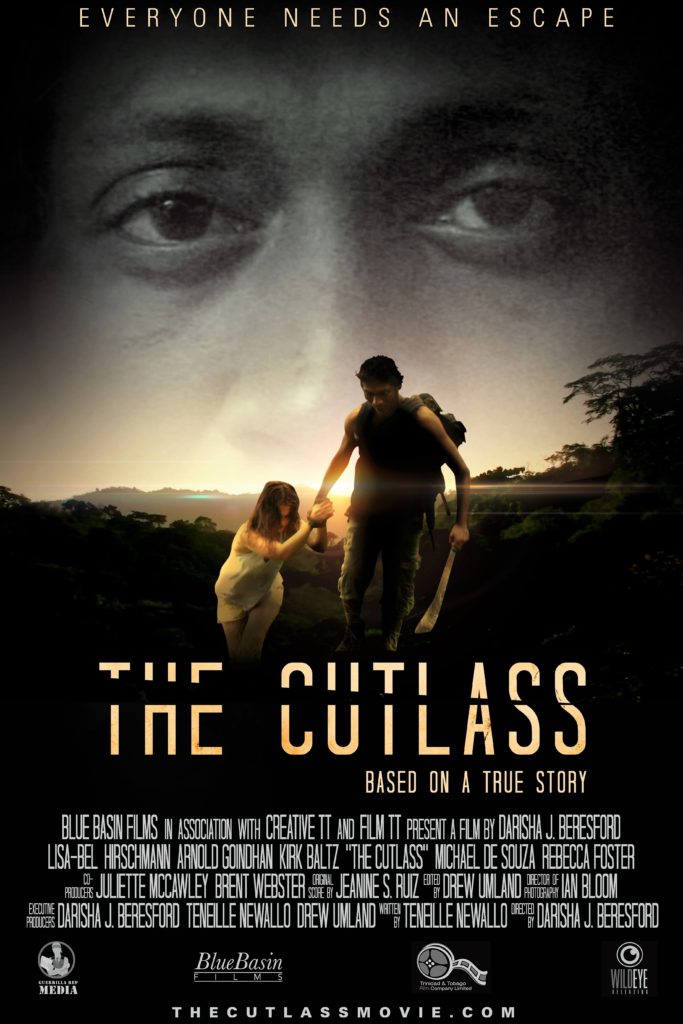
13″x19″ Poster Template
“Coolie” is the name of the character played by Narad Mahabir in the play by Errol Hill titled Man Better Man.
The local play was performed at NAPA in Port of Spain in June 2017, and an excerpt was staged later in August during the premiere of the CARIFESTA festival. Mahabir was given a minor role as the lone Indo-Trinidadian (Indian) villager in the musical which was laced with humorous dialogue, kalinda dances and calypso songs.
Except for recent plays written and directed by Indians like Victor Edwards, Seeta Persad and Walid Baksh, Indian actors and actresses have been given minor roles or none at all (“invisible”) in “national” theatre and cinema. In this context, The Cutlass is a movie with a difference. And indeed, the tagline of the movie on the cinema poster is “A breakthrough in Caribbean Cinema.”
Surprisingly, Arnold Goindhan is given the lead role (by the non-Indian Teneille Newallo) as the kidnapper named “Al” in The Cutlass. Paradoxically, he is given only a fleeting presence in the film’s trailer. He is the only Indian actor, and the only Indian character, in a movie that is based on crime, race and class.
As a villain, Al is portrayed as an evil Indian Hindu. A calendar painting of the anthromorphic Hindu god, Lord Hanuman (The Remover of Obstacles) is captured fleetingly on the wall of Al’s forest camp. In the filmic world of poetic justice, light must overcome darkness, whiteness must overwhelm blackness, and Christianity must conquer Hinduism. The pendant of Virgin Mary in the hands of the white kidnapped victim must overpower Hanuman.
Goindhan is a full-time Indian actor from Malick in Barataria who also sings and plays music. The “Island Movie Blog” in August 11, 2017 noted that when Goindhan “keeps his portrayal subtle, he really shines.” The 2017 July/August edition of the Caribbean Beat magazine stated that The Cutlass has delivered “compelling performances” to audiences.
The kidnap movie premiered to a sold-out audience at the T&T Film Festival in 2016 and received rave reviews. It copped the T&T Film Festival’s Best Trinidad and Tobago Feature Film and People’s Choice awards. The Cutlass was also screened at international film festivals such as the Cannes Film Mart at the Cannes Film Festival in France.
The last time an Indian was chosen for a major role in a local feature film was in 1974, 44 years ago. That film was titled Bim which featured Ralph (Anglicised from Rabindranath) Maraj playing the role of Bim/Bheem Sing. Bim was based on the composite life of notorious assassin, Boysie Singh, and aggressive trade unionist and Hindu leader, Bhadase Sagan Maraj.
As an actor, Ralph Maraj was preceded by Basdeo Panday who became the first Indian in the Caribbean to appear on a big screen in Nine Hours to Rama (1963). The movie was about the assassination of Mahatma Gandhi. Panday also acted in two other British cinematic movies: Man in the Middle (1964) and The Brigand of Kandahar (1965).
But the Indo-Caribbean actor who has earned the honour of starring in the most movies – Hollywood included – is Errol Sitahal. He acted in Tommy Boy (1995), A Little Princess (1995) and Harold & Kumar Go To White Castle (2004).
Valmike Rampersad and Dinesh (“Dino”) Maharaj are rising stars to watch. Originally from Cedros, Dinesh is the lead actor in Moko Jumbie, a new feature film by Indo-Trinidadian-American Vashti Anderson. Moko Jumbie was selected for screening at the 2017 LA Film Festival.
Dinesh acted in the local television series, Westwood Park (1997–2004). His cinematic film credits include portrayals in Klash (1996), The Mystic Masseur (2001) and Jeffrey’s Calypso (2005).
On Nadia Nisha Kandhai, I would write an entire article soon. She is the lead actress in the up-coming screen adaptation of the novel, Green Days by the River.
There is a real danger in marginalising Indians in theatre and film when they are in fact the largest ethnic group in Trinidad and Tobago (T&T) according to the 2011 CSO census data.
Cultivation theory states that images in the media strongly influence perceptions of the real world. This theory was developed by communication researchers George Gerbner and Larry Gross of the University of Pennsylvania in 1976.
The Cutlass can transmit the following wrong perceptions of reality: (1) Hinduism is evil, (2) Indians are one percent of the population, (3) there are few Indian actors, (4) Indians constitute the majority of kidnappers, and (5) the majority of kidnapped victims are white.
I presented a research paper in 2005 based on 40 cases of kidnapping in T&T. My findings revealed that 78% of the victims were Indians, and according to the survivors, the overwhelming majority of the kidnappers were ex-police and army Afro strongmen.

is a full-time anthropologist at the University of Guyana (UG) and Fellow of The Eccles Centre for American Studies, British Library (2022-23). He is a former Assistant Professor at the University of Trinidad and Tobago (UTT). He obtained his Ph.D. in Anthropology from the University of Florida (UF). As a doctoral student, he won a Florida Caribbean Institute Award, an A. Curtis Wilgus Grant, and an Organization of American States (OAS) Fellowship.
Mahabir received a National Award (Hummingbird Silver Medal) for his contribution to education in his country in 2011. He was among 50 recipients who received a Distinguished Alumni Award from the UWI Alumni Association.
Mahabir is the author of 12 books to date.
